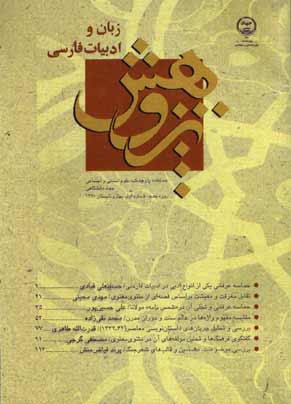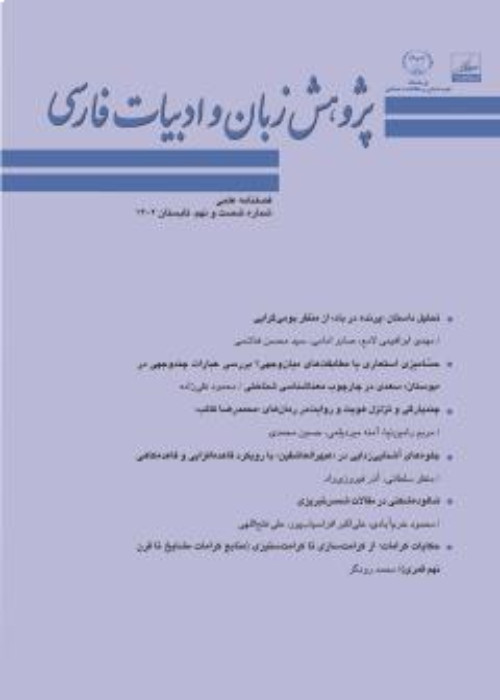فهرست مطالب

فصلنامه پژوهش زبان و ادبیات فارسی
سال چهارم شماره 2 (پیاپی 7، پاییز و زمستان 1385)
- 138 صفحه، بهای روی جلد: 10,000ريال
- تاریخ انتشار: 1385/11/17
- تعداد عناوین: 7
-
-
صفحه 1تصوف و عرفان از مهم ترین جریانان های فکری و معنوی اثرگذار بر هنر ایران بوده است. در طریق صوفیه جهت رسیدن به کمال مطلوب، مراتب و مقاماتی وجود دارد که هر یک از عرفا با توجه به مقام معنوی و میزان دریافت خود از طریقت آنها را برشمرده و نامگذاری کرده اند. تصوف از طریق ایین فتوت و جوانمردی به هنرها و صنایع راه پیدا کرده و از این طریق نفوذ خود را در معماری و به خصوص معماری مساجد نمایان ساخت. یکی از جلوه های ظهور عرفان در معماری مسجد وجود مراتب عرفان در آن است که با مدد از خصوصیت تاویل پذیری معماری می توان هفت شهر عشق عطار را...
کلیدواژگان: تصوف، عرفان، عشق، عطار، فتوت، مسجد، معماری، هفت وادی -
صفحه 21نوع نگاه به جنگ و نیز درونمایه ها، شخصیت های اصلی و چهار رویکرد، یعنی رویکرد ارزش حور، جامعه محور، انقاد محور و انسان محور را در حوزه ادبیات داستانی جنگ پدید آورده است. در رویکرد ارزش محور ستایش از پایداری، مقاومت و دفاع از میهن و اثر مثبت فرهنگی و اعتقادی دفاع در مرکز توجه داستان نویسان بوده است. هدف نویسندگان این آثار تهییج و تقویت روح سلحشوری و ارتقا روحیه استقلال خواهی، انجام دادن رسالت عقیدتی و دفاع از ارزش های انقلابی و اسلامی است. در رویکرد جامعه محور به بازتاب مصائب جنگ و جنبه های منفی و تاثیر تخریب های آن بر زندگی...
کلیدواژگان: ادبیات داستانی، داستان جنگ، نقد ادبی -
صفحه 37داستان کوتاه، از نظر فشرده سازی و حذف و گزینش، روند تکاملی را طی کرده است که برخی مراحل و نشانه های آن، در آثار ناب کلاسیک ادبیات فارسی و شاید برجسته تر از همه، گلستان سعدی، دیده می شود. هنر آغاز یا به عبارتی انتخاب نقطه آغاز پیش از آنکه در آثار نویسندگان بزرگ امروز تجلی یابد، در حکایات گلستان دیده می شود. جایی که انتخاب نقطه شروع مناسب، سبب شده است تا منحنی های ادراکی و احساسی در کوتاه ترین زمان ممکن بر هم منطبق شده برداشت ذهنی و حظ حسی به صورت تلفیق شده در سیستم عصبی خواننده پدید اید.
کلیدواژگان: آغاز داستان، بررسی ساختاری، داستان کوتاه، حکایات سعدی، گلستان -
صفحه 59انسان از آغاز پیدایش برای درک و رسیدن به جاودانگی، به تلاش های بسیاری دست زده است. او بدین منظور نمونه های جاودانه گوناگونی تصور کرده و ساخته است. یکی از آشکارترین این نمونه ها، تصور بناهای جاودانه است. در اساطیر ایران سخن از بناهایی است که به منظور گریز از مرگ و رسیدن به جاودانگی، ساخته یا تصور شده اند. این بناها، با ویژگی هایی ماورایی و با دیوارهایی از جنس سنگ های مقدس یا فلزند. بسیاری از این بناها، از نظام های مشترکی پیروی می کنند. با گذر از تفاوت های ظاهری و راه یافتن به لایه های پنهان این تصورات، می توان پی برد که تصور...
کلیدواژگان: بناهای اساطیری، جاودانگی، فلز و جاودانگی، گریز از مرگ -
صفحه 83مقاله حاضر با تاکید بر ضرورت تغییر مبنای منطقی تعریف ماهیت شعر از منطق دو ارزشی ارسطویی به منطق نسبی گرای فازی، ابتدا سه جریان فکری متمایز در حوزه شعرشناسی را مرور می کند. آن گاه با پذیرش دیدگاهی که ادبیات و به طور مشخص شعر را تافته جدا بافته ای از دیگر کنش های ارتباطی نمی داند و تحلیل زبان شعر را در چارچوب یک نظریه عام زبانی امکان پذیر می داند، تلاش می کند تا بر مبنای نظریه سیستمی- نقش گرای هلیدی و ملاحظه الگوی پیشنهادی مهاجر و نبوی تحلیلی نقش گرا از گفتمان شعری و پارامترهای زبانی و فرازبانی موثر در تحقق ارتباط شعری...
کلیدواژگان: زبان شناسی نقش گرا، شعرشناسی، منطق فازی، هلیدی -
صفحه 103مهابهارات اثر حماسی هندوان روایتگر جنگ پاندوان و کوروها بر سر حکومت منطقه ای به نام هستناپور است. در این جنگ که هیجده روز به طول می انجامد پاندوان بر پسر عموهای خود پیروز می شوند. ارجن در میان باقی قهرمانان این کتاب از نظرگاه های متفاوت شبیه رستم، جهان پهلوان شاهنامه است. این مقاله به مقایسه دو قهرمان از دو فرهنگ حماسی پرداخته است ارتباط با خدایان ازدواج در شهری بیگانه، جنگ با حاصل این ازدواج که پسری است، آگاهی از وجود دارویی زندگی بخش، رفتن به سفرهای خطرناک هفتگانه، کشتن برادر از جمله موارد مشترک میان این...
کلیدواژگان: ادبیات تطبیقی، شاهنامه، مهابهارات، رستم، ارجن -
صفحه 115هرچند داستان گویی نمایشی در سرزمین ها و زمان های مختلف همواره وجود داشته، در ایران روال رو به رشدی نداشته است. پیش از اسلام، گوسان های پارتی و خنیاگران ساسانی، هنگام داستان گویی از موسیقی، رقص و آواز و احتمالا همراهی چند بازیگر بهره می گرفتند. این نوع داستان گویی در جریان تغییر مذهب ایرانیان از آیین زردشت به اسلام، جوهره خود را حفظ کرد، اما برخی ویژگی های خود را از دست داد و بر بازیگری داستان گو اتکا پیدا کرد. در دوره اسلامی به سبب محدودیت هایی که در پی تفسیر آموزه های دینی برای هنرهای تجسمی و نمایشی به وجود آمد.
کلیدواژگان: ادبیات نمایشی، داستان، داستان گویی، نمایش، نمایش گری
-
Page 1Mysticism has had a great impact on the Iranian art. In order to reach the most paramount stage in suffism, there are several stages to go through. Each of these stages are defined by different mystics differently. Suffism has even penetrated into industries and art, and this way it was manifested in architecture of mosques. The structure of mosques can be taken as one of the manifestations of mysticism.
-
Page 21Types of attitude toward war and also toward the themes, main characters and….. are of four approaches, namely the value oriented, society oriented, critic oriented and human oriented; these approaches in literature have created war fiction.In the value-oriented approach the defence, protecting country, and the war are the focal points of the story tellers. The story tellers’ main purposes are promoting the heroship, feeling ideology-oriented reponsibility and protecting Islamic and Revolutionary values. The society oriented procedure reflects the war calamities and its effects on the people life and society. The minor and social issues and its devastating image are put on the sharp focus and its impacts on the people life and the cities and villages in which the family bases are changed. Critics oriented approaches deals with the uncertainty in the war and criticizes it. The story tellers’ view toward the war is negative and mostly is focused on the cities. Human oriented approach deals with human in war and the war generated by him regarding the human dignified value.
-
Page 37Insofar as it is related to techniques of story writing such as diction, omission, etc. short stories in the west have evolved to a great extent. These elements, that is, literary devices, can also be seen in the Persian classical works of literature. Terms such as Point of departure, and prolepsis, found in the works of great writers such as chekov, Allen Poe, Pomasant can also be found in Sadi's "Golestan". Point of departure in stories will lead to the emergence of perception, and neurological curves in the shortest period possible. The present paper is aimed at comparing Golestan with the stories of the west in this regard.
-
Page 59Ever since man appeared on earth, he has made every effort to achieve immortality. To do this, he has made imaginary symbols of immortality. Of the most prominent of these symbols are the imaginary eternal buildings. In the ancient Iranian mythology, there existed buildings in which one would be protected from death and become immortal. These buildings have apparently been made of sacred stones or metal, enjoying supernatural characteristics. Many of these buildings shared the same patterns. Disregarding the formal differences, one comes to understand the deeper hidden layers of these imaginations, and that these imaginations somehow give form to eternity. It has been the objective of this paper to probe into these characteristics in order to illustrate that all these buildings share the same origin, and features.
-
Page 83Emphasizing the necessity for changing the logical approach to the definition of the nature of poetry from Aristotle's logical dichotomy to the Fuzzy relativist logic, the present paper will first deal with three different viewpoints in the field of poetics. Attempts will also be made to employ the approach which does not take into consideration literature and poetry in particular, as being different from other types of communicative acts. It will thus be possible to analyze poetry within the framework of a general theory. Based on Haliday's functional systemic theory (1985, 1994) and taking into consideration the pattern proposed by Mohajer and Nabavi (1376), The present paper attempts to provide a functionalist analysis of the discourse of the poetry, as well as linguistic and paralinguistic parameters, based on
-
Page 103Mohabahart is an Indian work of epic, which narrates the war of Pandowan between the five sons of Raja Pand and gurus, the sons of Raja, to rule over a region called, Hastnapur. In this eighteen-day war, Pandowan defeats his cousins. Arjan, one of the characters, who shoulders a large number of responsibilities during different events, resembles Rostam in many ways.It is the objective of this paper to compare the two champions: their relations with gods, their marriage in a foreign land, having a son, becoming aware of revitalizing herb, going on seven dangerous journeys, and finally each killing his own brother. Attempts have been made to prove that due to the immigrations of the tribes from Iran to India, the Iranian beliefs, customs, and mythology, have had a profound impact on Indian epics.
-
Page 115Story-telling has always existed through time in different lands. However, it so appears that it has not undergone much of a development in Iran. Before the emergence of Islam in Iran, the Parthian Gossans and Sassanind musicians made use of music, dance, songs, probably a number of actors and actresses. In the course of change of religion from Zoroastrianism to Islam, story-telling preserved its nature, though it lost its characteristics such as dance and music, mainly relying on the artistic features of the narrator. Due to restraints existing in the Islamic period which followed the interpretations of the religious teaching concerning arts and drama, story-telling was somehow limited to the narration of merely one person called "Tazieh" (passion play). The very same constraint, however, reinforced drama and became the source of development for Tazieh.


